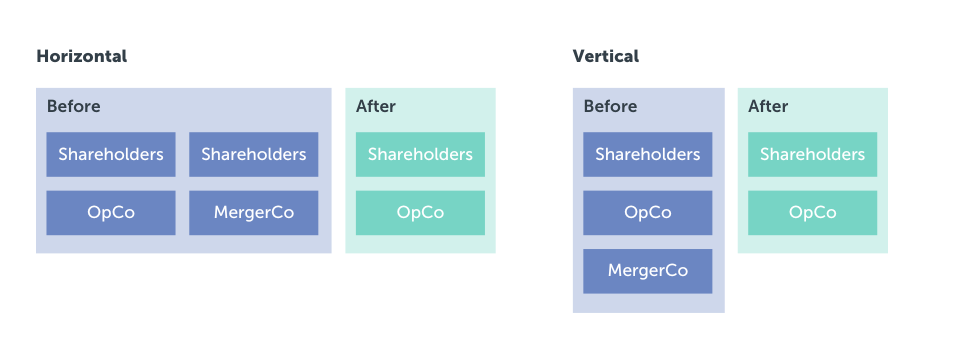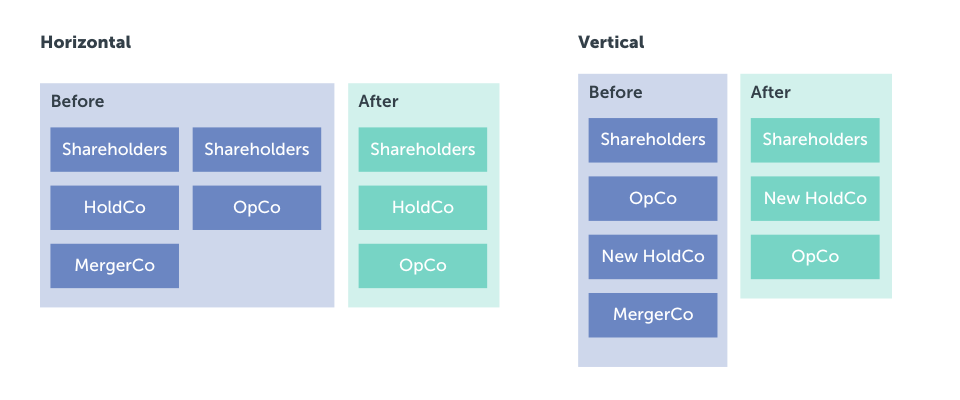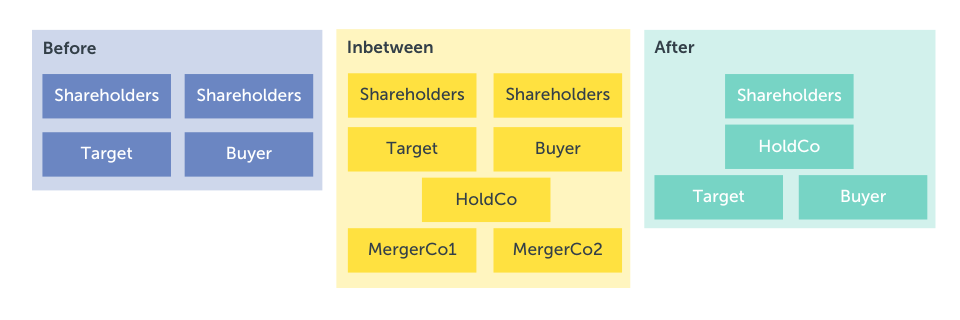Mastering the art of mergers
US lawyers will be intimately familiar with how mergers can be used for both classic M&A deals and in a wide variety of restructuring transactions. For corporate lawyers used to other legal regimes (notably the UK and Hong Kong), that do not have the concept of a true merger, the extraordinary flexibility of this tool may come as more of a surprise.
We have written before in detail on the process of a merger under BVI and Cayman law (for a general guide see here and here) and so this article skips over the legal formalities to focus on some of the different ways mergers can be used and structured, and what drives those structuring considerations.
What is a merger?
In a true legal sense, a merger is simply a transaction by which two or more legal entities combine their corporate existence so that just one combined entity remains. The merged entity inherits the assets and liabilities of the merging companies.
Mergers are permitted by statute in the BVI, Cayman, and Bermuda. In all three jurisdictions the relevant laws have been heavily influenced by the US, and particularly Delaware.
What can mergers be used for?
Mergers can be used for a number of different things, including:
- For the sale and purchase of a business (see further here, for a discussion of how mergers and other tools can be used in this context, and their pros and cons)
- As a method of changing corporate domicile (see here)
- To squeeze out minority shareholders*
- As a route to a public listing
- To take a public company private
- As an alternative to liquidations, particularly for multiple entities
- For a variety of solvent restructurings and reorganisations (see here)
*Depending on the jurisdiction concerned, and the constitutional documents of the relevant company, a merger may require a considerably lower voting threshold than other types of statutory squeeze out. It may also be more easily enforced than a contractual ‘drag’ right.
More than one option?
Several factors can influence the choice of a particular merger structure, meaning it is important to tailor the approach to the unique characteristics of each deal. These factors include:
- Tax: Tax considerations of the jurisdictions involved can significantly impact the choice of a merger structure. Although none of the BVI, Cayman, or Bermuda currently applies any corporate taxes, many offshore companies are actually tax resident onshore. Even if they are not, the location of shareholders and other merger parties may bring tax considerations in other jurisdictions into play. In a takeover effected by merger, the goal may be to optimise tax efficiency for both the acquiring and target companies.
- Regulation: Both industry-specific and general regulation can play a crucial role. Compliance with antitrust laws, securities regulations, and other relevant laws can dictate the permissible structures.
- Public status: SPACs (Special Purpose Acquisition Companies (see further here)) often opt for specific merger structures to bring a target company to market and companies may consider mergers for the purpose of de-listing from stock exchanges. In both instances, specific structures to meet regulatory obligations may be required.
- Corporate governance: Existing corporate governance structures and shareholder agreements may restrict what is and isn’t possible and a certain structure may be chosen to deal with uninterested or uncommunicative shareholders. Similarly, some structures may be more appealing to certain types of shareholders.
- Financials: The financial health and stability of the involved entities can influence the merger structure. Companies with varying financial positions may opt for structures that address specific financial needs.
- Complexity: The complexity of a deal, including the number of parties involved, the size of the transaction, and the nature of the assets or businesses being acquired, can impact the selection of a structure. Where a deal is of a lower value, it may not be sensible financially to overly complicate the approach to the merger.
- Minority shareholders: Whether or not there are minority shareholders likely to object to the transaction and whether there is a serious risk of litigation may drive the way a merger is structured or even whether a merger is appropriate.
- Future exit: Considerations regarding a future exit strategy may be important. Some structures may offer more flexibility for potential future divestitures or public offerings.
So what are the options?
Simple merger
The most common approach, and the simplest, is a two-party merger. This can be vertical or horizontal, ie, the merger of a parent and subsidiary or the merger of two unconnected parties.

Triangular mergers
As the name suggests, these mergers involve three entities, although only two of them strictly merge. This is how most takeovers in the US are structured. The buyer establishes a subsidiary to merge with the target company. The target company usually survives the merger and is left as a wholly owned subsidiary of the buyer. The old shareholders of the target usually receive merger consideration in cash or shares in the buyer.
A similar version of this is used by SPACs for their de-SPAC, or business combination, transactions. The SPAC establishes a subsidiary to merge with the target company. At closing, the SPAC’s existing entity becomes the holding company of the group and the target’s existing shareholders become shareholders in it. This brings the target to market.
As with a simple merger, triangular mergers can be conducted in a vertical, as well as horizontal manner.*
*We recently acted in relation to a BVI company, listed on a foreign exchange (OpCo), looking to be taken private. Because of the specific requirements of the foreign exchange, we were able to cash out certain shareholders and not others. Instead, an election process was used which allowed electing and non-responding shareholders to be cashed out or to be issued with shares in a newly formed entity. Furthermore, to complete the take private, it was important that following the merger, the former OpCo ended up as a wholly owned subsidiary within the group. For this merger, two new BVI companies were formed to sit underneath the OpCo, (known as “MergerCo” and “New Holdco”). OpCo was merged with MergerCo, and OpCo’s shareholders received cash, shares in New Holdco, or a mixture of both, depending on how they exercised their election rights. This left New Holdco as the entity held by those OpCo shareholders who opted to roll over into the New Holdco.

Double dummy mergers
Double dummy mergers are commonly used where buyer and target are relatively equal in size with the structure providing specific tax benefits depending on how it is used.
This approach is one of the more complex options and involves the buyer and target forming a subsidiary, which will eventually become their holding company. The holding company establishes two new “dummy” entities which then merge with each of the buyer and the target, issuing cash or shares in the holding company, as appropriate, to the original shareholders of each of the target and buyer. At the end of it, the holding company sits above the target and the buyer and the original shareholders of each have either become shareholders of the holding company or have been cashed out.

MultiCo mergers
Under Bermuda, BVI, and Cayman law, there are no restrictions on how many companies can be merged in a single transaction. This can be especially helpful in reorganisation exercises where multiple entities are no longer needed and it provides a quicker and simpler approach to consolidating the various assets and liabilities of companies without having to go through an asset transfer process and subsequent strike off/liquidation.

Cross border mergers
As mentioned at the top of this article, the merger process is not one unique to Bermuda, BVI, and Cayman. Many jurisdictions have a form of merger process and BVI and Cayman law allow for companies incorporated in either jurisdiction to merge with foreign entities which also permit the concept of mergers. This can be an alternative to continuing out of the jurisdiction, and when multiple entities are being moved this can be a more cost effective and efficient move. However, cross border mergers are inherently a little more complex than mergers between entities in the same jurisdiction.
Final note
The Harneys corporate team has deep experience in advising on mergers in all of the contexts mentioned above. We also have a specialist team with expertise in dealing with merger related disputes when they arise.
Flexibility is a key aspect of offshore law, and that is very much the case with mergers.
The above are examples of how you can structure a merger but, as corny as it sounds, it’s your imagination that will limit what’s possible!


